Selected Topic
Issue 7 - On Canetti – Literature and Architecture: Letters, Words, Buildings (March 2012)
Show articles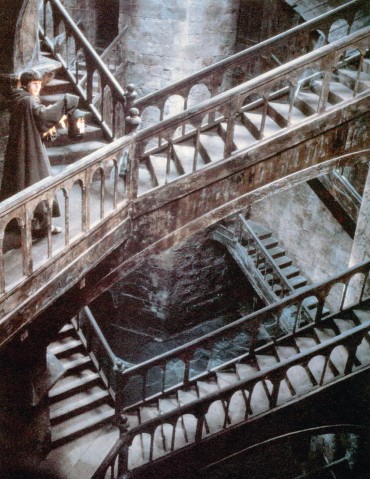
Behind-the-scene photo from Annaud’s movie adaptation The Name of the Rose. Adso (Christian Slater) gets lost in the Libra
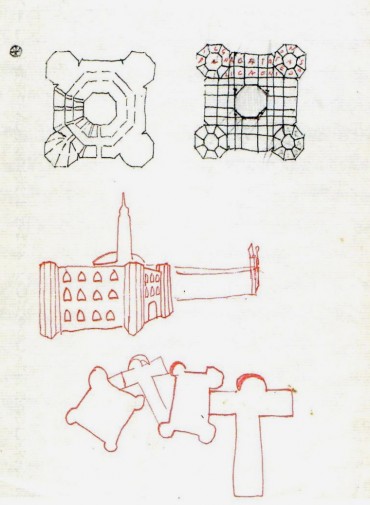
Eco’s sketches for the ground plan of the Aedificium and the compound of the abbey.
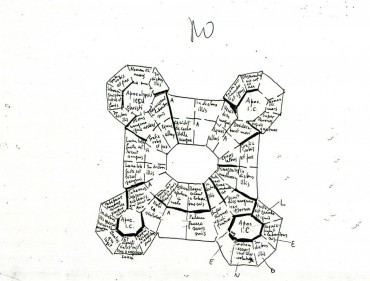
Eco’s final ground plan for the labyrinthine library with notes on the inscriptions.
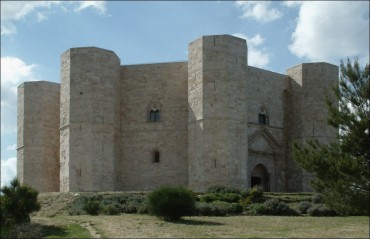
The Castel del Monte in Apulia, Italy serves as a reference to Eco for the monastic Aedificium.
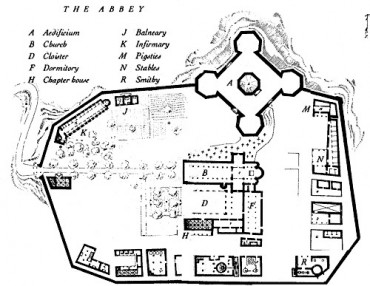
The layout of the abbey as Eco adds it to his novel.
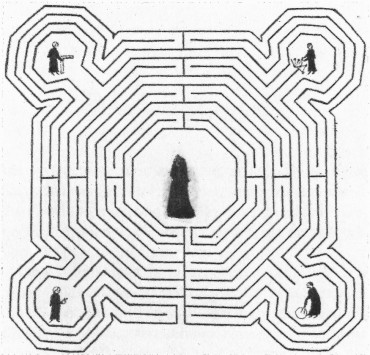
Diagram of the former labyrinth inlaid on the floor of the cathedral of Reims.
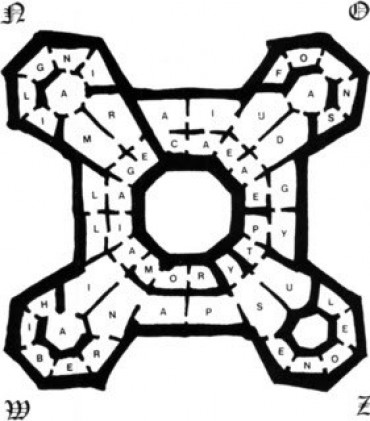
The ground plan of the library as illustrated in the novel.
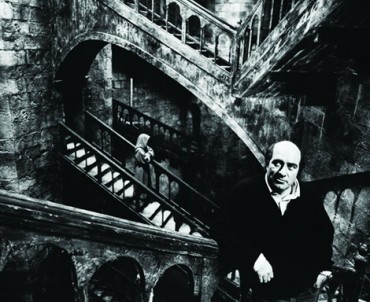
On-set photo with Dante Ferretti in front of the stairways of the library’s interior set. (Courtesy of Dante Ferretti)
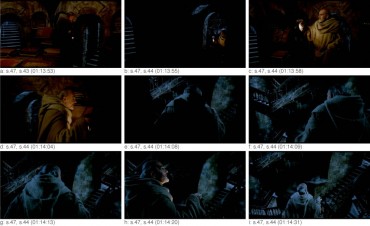
Screenshots - Scene 47
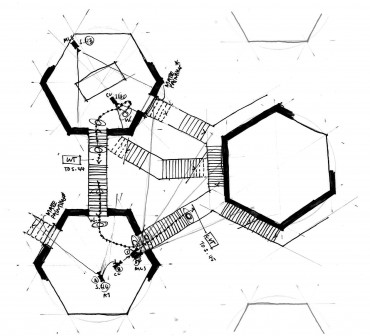
Scene 47 - shots 42 to 44
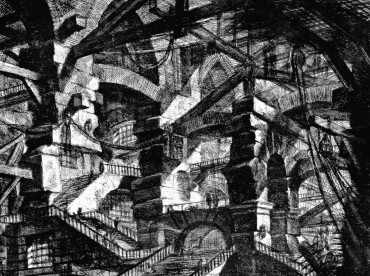
Piranesi’s Carceri, table XIV, II. condition
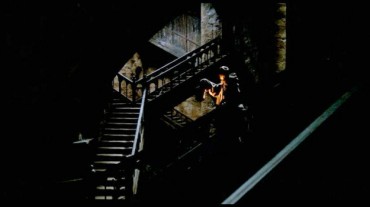
Adso gets lost in the labyrinthine library
4.7.2012 – Issue 7 - On Canetti – Werder Vanessa – Essays, Studio
The Name of the Rose - The Monastic, Labyrinthine Library and a Comparison of its Illustration in the Book and the Movie
by Vanessa Werder
"Hunc mundum tipice laberinthus denotat ille ... Intranti largus, redeunti sed nimis artus.“
Alinardo of Grottaferrata in The Name of the Rose (1)
In the fall semester of 2011, the design course led by the Chair for Architecture and Design of Prof. Dr. Josep Lluis Mateo at the ETH in Zurich examined the correlation between architecture and literature. The students were given the task of designing a library on top of the Winkelwiese hill in Zurich. As a theoretical approach, I have decided to further explore this topic by analyzing a literary description of such a library. Umberto Eco’s novel The Name of the Rose portrays a library, which is designed as a labyrinth and has a mysterious feel. This library, I find, serves as a brilliant sample for an extended research.
One of the principle tasks of an architect is to shape rooms and spaces. In a similar way in which an architect uses his plans and sketches to illustrate his vision, a writer uses his words to express his thoughts. In fact, Eco seems to be an author who is very concerned about being precise in not only describing historical events, but also in setting the architectural backdrop of his novels. His intentions have also been visualized in Jean-Jacques Annaud’s movie of the same title.
Since I am pursuing a career as a production designer on a movie set, this transformation from words to images peeks my interest. In the following essay, I will attempt to explain why Eco places so much emphasis on the architectural design in his novel, and particularly why he conceives the monastery’s library as a labyrinth. Furthermore, I will be utilizing the adaptation of the movie as a basis for comparison. I will try to demonstrate the thoughts and mechanisms that stand behind the novel’s adaptation and uncover the reasons for the divergent illustration of the library into two media.
Umberto Eco‘s novel The Name of the Rose was first published in 1980, in its original language, Italian. Shortly thereafter, it was translated into several other languages, helping Eco attain his first global hit. The first-person narrator of the novel, the aged Benedictine monk Adso of Melk, depicts his recollection of events in 1327 as he experienced them during those seven days as a young man in an Italian abbey. Together with Franciscan friar William of Baskerville, Adso investigates a series of mysterious murders committed on the monks. A hint prompts them to advance into the cryptic library. The two medieval detectives work to figure out the puzzle amongst the stacks of books in the labyrinth.
Eco considers the Middle Ages not only as a mere scenery, but rather as an additional character of his novel. Therefore, he attaches a great deal of importance to the surroundings and architecture. This is seen in the significant design of the library, which acts as a vessel for the storyline, where key activities take place. (2)
Before Eco started writing his novel, he had drawn countless plans and sketches to compose the compound of the abbey. Additionally, Eco paid extra attention to detail and historical precision. In the course of writing, he always bore in mind the ground plans of the buildings. (3) The specific importance of the library is highlighted with the added ground plan within the pages of the novel. Revealing the ways through the library with all its rooms and inscriptions allows the reader to follow Adso and William‘s discoveries inside the maze. It must be pointed out that Eco does not do this before Adso and William figure out the layout of the library themselves.
In the first few pages, Adso already describes his initial impressions of the abbey. It is not the monastery‘s compound that leaves him astonished, but rather the massive construction of the Aedificium, wherein the library is located:
“I was amazed, not by the walls that girded it on every side, similar to others to be seen in all the Christian world, but by the bulk of what I later learned was the Aedificium. This was an octagonal construction that from a distance seemed a tetragon (a perfect form, which expresses the sturdiness and impregnability of the City of God) [...].“ (4)
Adso‘s feelings are reinforced by the subsequent conversation with the monastery‘s abbot. The reader and the two protagonists learn that the library is a spiritual and mundane labyrinth at the same time. The abbot is spelling out the prohibition of entering the library. Only a selected few, like the librarian and his assistant, are allowed to enter the world of books. “The library defends itself [...],“ (5) expresses the abbot, thereby provoking Adso and William‘s curiosity and suspiciousness.
Eco found a historical reference for the Aedificium in the Castel del Monte, which was built around 1240 in Apulia. Yet it differs from the type of a library. Eco‘s Aedificium accommodates the kitchen and refectory on the ground floor, the scriptorium in the upper floor as well as the library above it. He knowingly uses an anachronism and invents his own building type. The combination of kitchen and library would have never been housed in the same building, because the fire would be too big a risk for the valuable books stored in the library. Though Eco illustrates the Aedificium as a symbol for the oppositional struggle between carnal and spiritual desires within human beings. (6) Constituting the library as a labyrinth probably has various reasons. Certainly, Eco was influenced by contemporary floor patters showing labyrinths in medieval churches, but his idea goes beyond mere spatial qualities. Within the scope of a lecture (7) Umberto Eco delineates his idea of an ideal library. To depict this notion Eco uses the image of an anti-model which he established in the library of the novel. There is neither a clearly laid out pattern, nor is the access granted to anybody. Ultimately, the user is not even allowed to borrow the books he likes to. So, the library is not a collective vessel of knowledge, that nourishes the curious, but more like a prison, as it is uttered by the abbot:
“If God has now given our order a mission, it is to oppose this race to the abyss, by preserving, repeating, and defending the treasure of wisdom our fathers entrusted to us.“ (8)
The labyrinthine ground plan enhances this image of a dungeon-like prison. The library is about a manneristic labyrinth constructed as a maze with branching alleys and dead ends. Another source of reference is found in Jorge Luis Borges description of a world erected as an infinite, labyrinthine library. Eco understands this as an anti-model, too and describes it as a “horrifying nightmare [...] an absolute structure of terror.“ (9)
The library is not only an expression of an extravagant architectural fantasy, but reflects itself metaphysically in the plot and the three main characters. The architectural form is superimposed onto the storyline and its confusions. Likewise the cryptic labyrinth, the uncovering of the mysterious murders leads to wrong directions and dead ends. William of Baskerville admits having found the right way only by detours and chance. He discovers the answer to the riddle by assuming an inexistent coherence between the prophecy of John and the murders. Therefore William is the personification of a rhizome-shaped (10) view of the world. There are neither wrong ways nor right ones. However, every path leads to the answer. The second disposition of a labyrinth - the baroque-manneristic labyrinth - is portrayed in Adso‘s behavior. Similar to the tale of Ariadne‘s thread, Adso‘s slightly naïve manner lets him stray around in the library eventually finding his way out through a principle of trial-and-error. Jorge of Burgos, the blind old man and actual ruler of the monastic library, relates to the third kind of labyrinths: The classical labyrinth, known from Ancient Greece and its myths. On the one hand the library‘s cosmos corresponds with Jorge‘s perception of a self-contained world (11), on the other hand, he himself represents the Minotaurus, who marks the center of the library - the secret room Finis Africae, where he awaits the intruders.
The complexity and ambiguity of the novel have fascinated the French director Jean-Jacques Annaud in the same way. Even though he was aware of the difficulties that would emerge with turning the book into a movie, Annaud would assure all rights for the adaptation for The Name of the Rose. Having gained Umberto Eco‘s approval, Annaud converted the novel into a movie script. The German-French-Italian production was first shown in theaters in 1986. Some cutbacks of intellectual facts, such as descriptions of the political and clerical situation, and modifications of dramaturgy are accepted. The movie still amazes with its congruency to the eponymous novel. (12)
Umberto Eco is very precise in describing the spatial and atmospheric look of the library, emphasized by the added ground plan. It is rather rare that literary originals cover such detailed descriptions of settings and surroundings. More than ever it is surprising that the library has a completely different layout in the movie. Annaud has some very pragmatic reasons for his interpretation: Eco‘s labyrinth is arranged in narrow alleys. This does not only limit the camera‘s perspective and its range of movement, it is also very difficult to bring out the complexity and circuitousness to the viewer. Annaud adds, that in his opinion, there is no reason in creating a two-dimensional labyrinth when it is located in a tower. “The psychological effect is augmented, when the tower is completely filled with the labyrinth,“ as Annaud states in an interview (13). According to the importance of the symbolic meaning of the labyrinth, it is beyond question that it has to be visualized as such in the movie, too.
Dante Ferretti, who is the production designer of The Name of the Rose, accepted the challenge and converted Eco‘s vision in a multi-story entanglement of stairways. One of the main issues, when turning a book into a movie emerges here: Whereas the book mainly uses words to communicate, the movie has to illustrate the same content and intention through images. The descriptive narration of a book does not only describe the shape and type of a setting, but also its impact on the protagonist. As the narrator, Adso depicts his first impressions of the abbey and revealing his feelings at the same time:
“I will not say, that in any case, that it prompted feelings of jollity. I felt fear, and a subtle uneasiness. [...], and I was rightly interpreting indubitable omens [...].“ (14)
What is easily said with words implies an exceptional effort to portray the same sentiment in images. We perceive the actors feelings through their gesticulation and facial expressions. Also light and music help to transport a certain ambience. At best, the scenery and set design support these impressions, too.
Ferretti discovers a remarkable example in Giovanni Battista Piranesi‘s Carceri (15). The Italian artist created these etchings in around 1750. Piranesi‘s illustrations show bare, sinister and almost infinitively appearing dungeons. Ferretti succeeds to transfer the library‘s complexity, narrowness and yet its immense dimensions into a believable set. His design also fulfills technical aspects and the audience‘s expectations.
Ferretti constructs a multitude of flights of stairs and alleys that lead swayingly from room to room, likewise Piranesi‘s imagination. The setting was constructed as a studio set, which enabled Tonino Delli Colli, the director of photography (D.O.P.), to picture the setting in the same manner as Piranesi did before him. The steep bird‘s eye view and the diagonal perspective enhance the spatial illusion. The visible space might as well continue infinitively. Stairs and alleys are rarely concluded and often lead out of the framing. Some actions take place off camera and are only indicated by sound and noise. This alienates the spectator and leaves him with a feeling of unease and lack of control.
Delli Colli‘s framing often lets the viewer observe the action through an archway, a flight of stairs or under a table covered with old books. This makes us feel like a tiny and secret observer of the action taking place (likewise the many rats that live in the vast library). We believe to have figured out the apparent order of the library, yet have to admit we got astray within it, like Adso and William.
Also the concept of the lighting shows distinctive parallels to Piranesi‘s work. The gloomy overall impression is generated through a cold, harsh and moonshine-like lighting. The wall‘s surfaces seem to absorb the light and leave the room in shadows. The light does not bring brightness, but rather darkness. All these methods of illustrating space let the spectator sympathize with the protagonist and be part of the adventurous investigations.
The movie production had a vast budget and no expenses were spared. Since the crew could not find a suitable location for the shooting, they decided to erect the whole complex of the monastery as an exterior set at the Cinecittà Studios near Rome. Also the library‘s interior was built as a studio set. This allowed Dante Ferretti to build his own vision of the library and giving the technical crew enough room to put their lighting and camera equipment properly into position.
Especially with the setting of the library, the exceptional collaboration between director, D.O.P. and production designer is exemplified. The production designer created his set with the creative and technical inputs of both the director and the D.O.P. He had to meet not only their demands, but also the audience‘s expectations. This task asked for a design process on a multitude of different levels at the same time - therefore, resembling the working process of an architect.
In my opinion, Dante Ferretti‘s idea of the sinister and labyrinthine library creates an authentic and believable image that stands in no way behind the literary original. The spectacular setting makes up for the neglected additional secrets the library bears that Eco constructed so masterly. (16)
Every little detail and prop was approved by medieval experts before going into production. Despite that, Ferretti dares to introduce the audience to a major anachronism: Medieval craftsmen would not have been able to construct the free hanging stairways. This tightrope walk between historical faithfulness and artistic imagination is paying out. The viewer does not question the liability of the setting. Ferretti purposely commits this mistake. Stylistic errors are very important for the authenticity of a setting. Perfect reconstructions appear boring. “Nothing is perfect in reality. As soon as some mistakes are made, it starts to look real,“ as Ferretti explains his risk taking. (17)
Referring to Piranesi’s Carceri seems to be very appropriate. The successful execution equals the impressions Eco is pointing out in his novel. Borrowing an architectural style from a different era points out the timelessness and universality of the setting. It also emphasizes the symbolic character of the labyrinthine library and touches the viewer on an emotional level, therefore, making us feel like being a part of Adso and William‘s discoveries.
1 Eco, The Name of the Rose (1980/83: 149). “The labyrinth represents the world allegorically ... Spacious for the one entering, but extremely narrow for the one returning.“
2 Steiner, Ulrike, "Der Name der Rose" In: Architektur wie sie im Buche steht. Fiktive Bauten und Städte in der Literatur Hrsg.: W. Nerdinger, Munich, Verlag Anton Pustet, 2007, p. 396.
3 Eco explains to La Repubblica (2006) that he has not written a single line within a year. He was only producing plans, schemes and sketches for the novel‘s settings. According to Marco Ferreri his dialogues even have the reputation to be very movie compatible. Because his characters stop talking as soon as they reach the end of the stairs. Hence the dialogues have always the exact length. (In: Eco, Nachschrift zum Namen der Rose [1983: 33]).
4 Eco, The Name of the Rose, p. 13.
5 Ibid, p. 30.
6 Steiner, Der Name der Rose, p. 396.
7 A lecture held by Eco for the event of the 25th anniversary of Milan‘s municipal library (Milano, 10 March, 1981).
8 Eco, The Name of the Rose, p. 28.
9 Eco, Die Bibliothek, München/Wien, Carl Hanser Verlag, 1981, p. 15.
10 A rhizome is a multi-dimensional linked network.
11 Jorge of Burgo‘s parallels to the Argentinian writer Jorge Luis Borges are definitely not coincidental.
12 Annaud entitles the movie as a “palimpsest of Umberto Eco‘s novel“ and makes clear that the book and movie are of different kind. He does not consider any claim of completeness of the book‘s content.
13 Baumann, Hans D., Sahihi, Arman, Der Film: Der Name der Rose. Eine Dokumentation, Weinheim/Basel, Beltz Verlag, 1986, p. 21.
14 Eco, The Name of the Rose, p. 14.
15 Coincidentally, Piranesi himself was influenced by the contemporary genre of set drawings.
16 Eco conceives the library as a built map the way the world was seen in the Middle Ages; where the North houses the books of northern Europe, the East bears the books from Greece and Asia and so on. During their investigation William is starting to understand the logic that lies behind the library‘s scheme. Hence, he is able to navigate amongst the stacks of books.
17 Ferretti states this in an interview with the Berlinale Talent Campus on 29 October 2010 (http://www.berlinale-talentcampus.de/story/91/1691.html: December 11th, 2011; 11:57 am).
Download article as PDF

